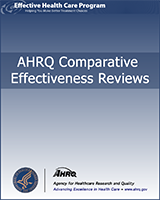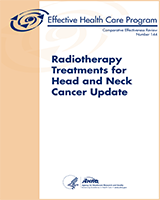NCBI Bookshelf. A service of the National Library of Medicine, National Institutes of Health.
Samson DJ, Ratko TA, Rothenberg BM, et al. Comparative Effectiveness and Safety of Radiotherapy Treatments for Head and Neck Cancer [Internet]. Rockville (MD): Agency for Healthcare Research and Quality (US); 2010 May. (Comparative Effectiveness Reviews, No. 20.)

Comparative Effectiveness and Safety of Radiotherapy Treatments for Head and Neck Cancer [Internet].
Show detailsThe available literature to assess the relative effectiveness of different techniques of radiotherapy in head and neck cancer on the whole consisted of poor-quality studies and, with the exception of late xerostomia and quality of life, a low or insufficient level of evidence. The challenges of conducting research in head and neck cancer need to be acknowledged. Head and neck cancers are not common, so the pace of patient accrual may be slow; this may be accompanied by changes in practices, both for the technology of radiotherapy itself and other aspects of management and treatment. Also, head and neck cancer patients are likely to be clinically diverse in terms of tumor site, histology, stage, prior and co-interventions, and other factors. On the other hand, the length of followup needed to study head and neck cancer treatments is relatively short compared to some common cancers, such as breast or colon cancer. A further challenge to evaluating radiotherapy techniques for head and neck cancer concerns the rapid pace at which these technologies are evolving.
Specific recommendations for future research:
- Promote multicenter trials to hasten patient accrual and trial completion.
- There are considerable obstacles to conducting randomized, controlled trials to ascertain tumor control and survival effects. These are: wide dissemination of IMRT, reluctance to randomize patients when effects on xerostomia are already known, the large numbers such trials would require, and other priorities for funding. Nonetheless, certainty about tumor control and survival outcomes can ideally be obtained through a robust randomized, controlled trial. Both treatment characteristics, including adjunctive treatments such as chemotherapy, and patient characteristics, e.g., prognostic factors such as age, stage, and comorbidities, can be confounding factors.
- While trial recruiting challenges may limit statistical power to test for effects among subgroups, trial protocols should prespecify subgroup analyses on prognostic variables such as patient age, site, stage, and tumor grade as well as user variables such as treatment experience, target volume parameters and dosimetric parameters.
- Statistical analysis should be conducted in accordance with preferred methods.163
- Recognizing that observational studies, including case series, will continue to be attractive to investigators, recommendations to improve the usefulness and generalizability of such comparative studies are:
- Conduct prospective studies with contemporaneous treatments being compared.
- Comparison groups should be comparable in terms of key variables, such as anatomic site, disease stage, and prior treatment.
- Multivariable regression analyses can be helpful in controlling for potential confounders and should adhere to good modeling practices.14–21
- Guidance for study quality in observational studies has been addressed by Deeks et al.10
- Additional features that would improve the quality of randomized, controlled trials, observational studies, and case series are:
- To facilitate comparisons between studies, outcome measures need to be standardized, such as the Common Terminology Criteria for Adverse Events.165
- Key outcome measures include tumor control, type and extent of toxicity and functional/quality of life status..
- Outcome measures should be valid and reliable, and their assessment should be blinded or otherwise be performed by an independent assessor well-trained in toxicity assessment.
- Quality-of-life and patient-reported outcomes should be assessed with validated instruments for which clinically significant improvements have been quantified empirically.
- Clear details are needed about timing, dose and specific chemotherapy agents given.
- Consistently conduct and report rigorous multivariable adjustment for confounding. Among other factors, this will require sample sizes sufficient to support multivariable analysis, consistent and thorough measurement of potential confounders, and good modeling techniques.
- Among the variables of interest are patient and tumor characteristics that may affect outcomes.
- Operator and performance characteristics should also be assessed for effect on outcomes. Characteristics of interest include experience and success in delivering prescribed doses.
- Xerostomia has a significant impact on quality of life. It appears to be common in patients with certain tumor sites, radiotherapy treatments and chemotherapeutic regimens. Older age and certain therapies for chronic diseases may increase susceptibility for this adverse effect. Research to improve the management of xerostomia and to disseminate that knowledge to clinical practice could potentially improve morbidity and quality of life for cancer patients.
- Future Research - Comparative Effectiveness and Safety of Radiotherapy Treatment...Future Research - Comparative Effectiveness and Safety of Radiotherapy Treatments for Head and Neck Cancer
Your browsing activity is empty.
Activity recording is turned off.
See more...
